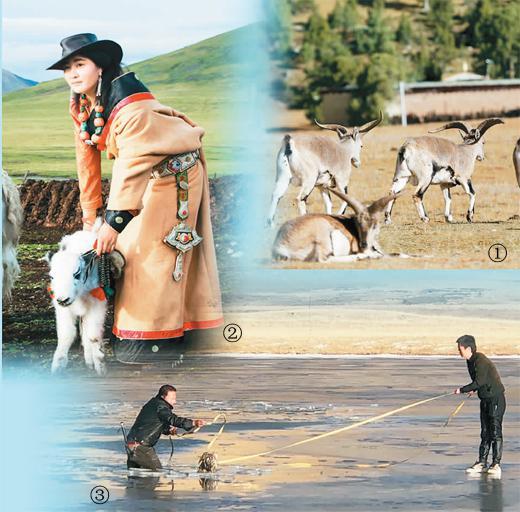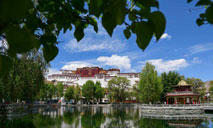China ramps up environmental protection efforts in Qinghai's Sanjiangyuan area
China has redoubled its efforts towards the protection of the Sanjiangyuan area in the northwestern province of Qinghai over the past years by establishing a national park.
The Sanjiangyuan National Park, China's first pilot national park, has been established to protect the local environment. The area is known as the country’s “water tower” because it houses the headwaters of the three great rivers of the country: the Yangtze, the Yellow and the Lancang rivers.

(1) Photo shows blue sheep, under second-class state protection in China, wandering in the Guoluo Tibetan autonomous prefecture, northwest China’s Qinghai province. (2) Photo shows a herdswoman taking care of her yak in northwest China’s Qinghai province. (3) Photo shows two rangers rescuing a wild animal trapped in broken ice on a lake in northwest China’s Qinghai province. (Photo/Courtesy of Sanjiangyuan National Park's management committee)
Covering a total area of 123,100 square kilometers, the national park emphasizes the protection of the entire ecosystem, including all of the local natural resources such as wild animals, water, grassland, and forests.
Since the national park started its trial operation in 2016, local herdsmen have been recruited to help protect and improve the environment. Their work includes patrolling the pasture as well as monitoring and rescuing the park’s wildlife. To date, there are 17,211 rangers operating in the national park.
Kunsang, now 39 years old, is a Tibetan herdsman-turned park ranger for the headwaters of the Yellow River in the national park. He usually starts work at 8 a.m. and finishes all his tasks by 6 p.m., noted the man, who has taken up the post since 2016.
On Nov. 16, 2020, Kunsang put his life at risk while attempting to save a wolf trapped in an broken ice patch on a lake. Braving temperatures of minus 10 degrees Celsius, Kunsang rushed over to the wolf and pulled the wild animal out from the icy opening on the frozen lake with the help of his colleague.
"The wolf was in danger, and I never thought about how cold the frozen lake water was," the man recalled, adding that all he wanted was just to save the animal in that moment, affirming that wildlife is of enormous value to the overall integrity of the the national park’s ecology.
The efforts of rangers including Kunsang are paying off, and the national park has seen its wild animal populations bounce back noticeably in recent years.
Hoh Xil (Kekexili) National Nature Reserve, one of the largest no man’s lands in China and a part of the Sanjiangyuan National Park, is now home to more than 70,000 Tibetan antelopes, said Wang Xiangguo, deputy director of the park. The official explained that the population numbers for the rare species, which is under first-class state protection in the country, once declined sharply to no fewer than 20,000 due to the impacts of illegal hunting.
Meanwhile, the national park has adopted new technologies to better monitor the water quality in the area. Since 2018, when an intelligent terminal operation system was first introduced, other technologies such as water quality sensors, video monitoring equipment, and unmanned aerial vehicles (UAV) have also now been widely applied in protecting water resources.
Local villagers have also joined in efforts to make the Sanjiangyuan area’s waters even clearer. They have not only made garbage sorting a part of their daily life, but also consciously picked up trash they happened to come across for disposal at centralized treatment in their villages.
"Environmental protection is a top priority for us, as its benefits are significant," said Chapu, director of Niandu village, Angsai township of Yushu Tibetan autonomous prefecture in Qinghai province. "Today, it is not rare to see seniors and children alike picking up rubbish alongside the meadows," the official added.
Thanks to all the joint efforts, the national park has also witnessed remarkable improvements in its ecological environment over the past five years.
The annual average water conservation volume grew by over 6 percent, according to a report from China’s National Development and Reform Commission released in March 2020.
The report also indicated that in the national park, the grassland coverage and grass yield also rose by over 11 percent and 30 percent respectively from a decade ago.
Over the past five years, two large lakes – Gyaring and Ngoring – situated in the Yellow River's headwaters region in the national park, saw their areas increase by 74.6 and 117.4 square km, respectively. Meanwhile, the area of wetlands has increased by 104 square km, and the number of lakes has reached 5,849.
Photos
Related Stories
- Ecological guards grow green future in Sanjiangyuan National Park
- Herdsmen in Sanjiangyuan area protect environment, benefit from ecological conservation
- Sanjiangyuan National Park releases first 4K HD video of Yangtze River source
- China’s Sanjiangyuan National Park becomes ideal home of Tibetan antelopes
- Sanjiangyuan National Park to invest 1 billion RMB in infrastructure in 2017
- Quantity of wild animals in Sanjiangyuan increases due to protection
- China protects key river sources
- 'Water tower' gets warmer as climate change bites
- China to spend 1 bln yuan to preserve major riverhead
- Qinghai to invest additional 1 billion yuan in Sanjiangyuan ecological area
Copyright © 2021 People's Daily Online. All Rights Reserved.










